Camargue Rules: Cowboys, Bulls and the Course Camarguaise
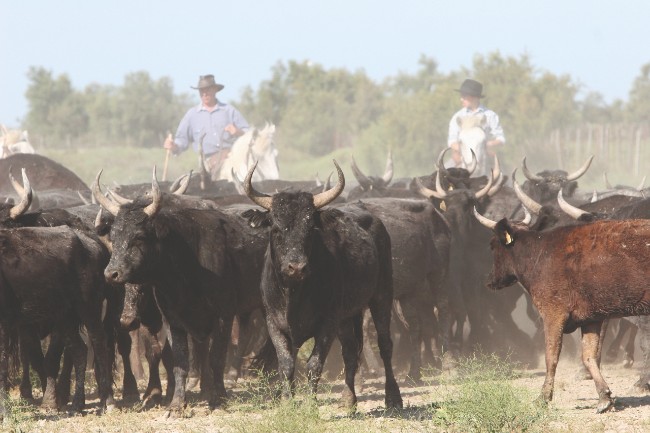

Chloe Govan visits the cowboys of the Camargue to discover centuries-old cultural traditions and encounter a humane version of the controversial art of bullfighting – without the bloodshed
Bullfighting: brutal and bloodthirsty, right? In most cases, absolutely. But in France, not necessarily. Welcome to the world of course Camarguaise, which challenges the concept that the relationship of the raseteur [fighter] with his bull has to be cruel.
Despite being less than a three-hour drive from the Spanish border, the culture of the Camargue is worlds apart from that of its neighbour. In a traditional Spanish corrida, the bull fights to the death and is repeatedly goaded in its final moments by men on horseback brandishing red flags. Lances are plunged into the neck and back of the distressed animal, paralysing its spine and rendering it helpless. Its ears are often sliced off while it is still alive as a distasteful trophy, before a final sword wound is delivered to its heart. Then as it collapses, a baying crowd delights in its suffering, seemingly caring very little that it never stood a chance.
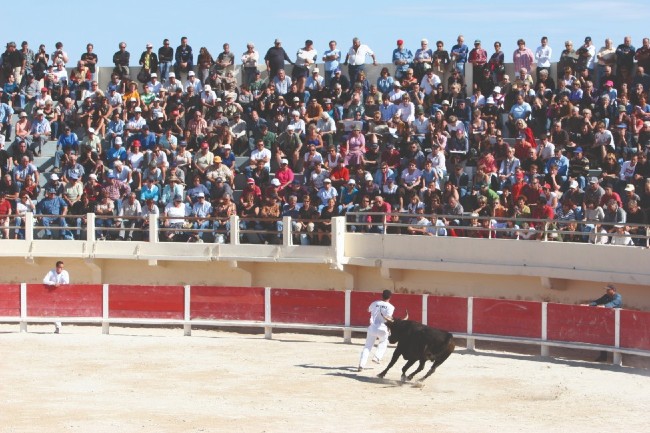
The course Camarguaise. Photo: Georges Vlassis
While this type of fight is nothing more than a sadistic slaying for bizarre public entertainment, the traditional course Camarguaise, as practised in France, couldn’t be more different. Here, the pampered bulls are never killed and typically “work” for a maximum of merely 30 minutes per month, doing little more than exercising their natural instincts to chase and pursue. The role of a raseteur is not to injure the cattle, but to dart nimbly around them like a mouse being stalked by a cat. The aim is to successfully snatch a tassel or rosette that has been placed on the bull’s horns, without being forced to retreat by the threat of its physical dominance.
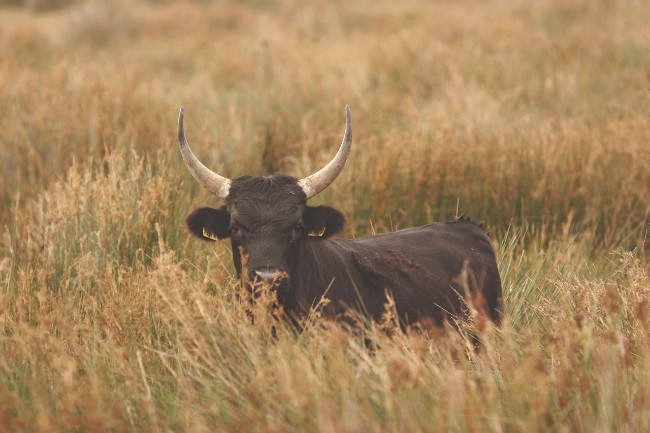
A bull at rest. Photo: Georges Vlassis
Another spin on the sport, the taureau-piscine, or swimming pool shows, sees both bull and man splashing through the water. Showmanship involves stunts such as jumping right over the bull and doing a backward roll in mid-air to reach safety, while less adept fighters are helplessly thrown to the ground or gored by the bull’s horns and pushed backwards into the pool with a monumental splash.
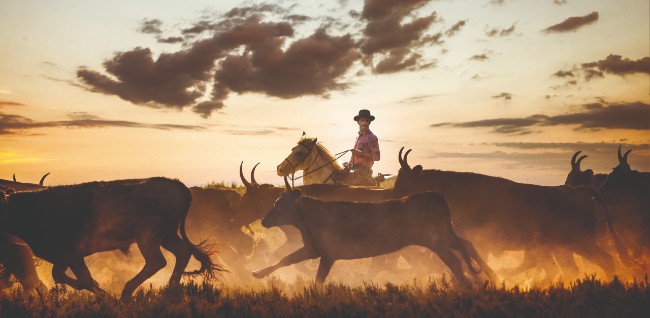
Cowboys riding with the bulls at the Mas de Peint ranch. Photo: Georges Vlassis
In return for stalking their human ‘predators’ two or three times a month, the bulls of the Camargue are elevated to veritable celebrity status. Their names and photos are emblazoned on promotional posters and spectators often choose which ‘fight’ to attend based on the bull heading the bill rather than the raseteur. In Spain, by way of contrast, it is the cruel matadors who are branded the stars.
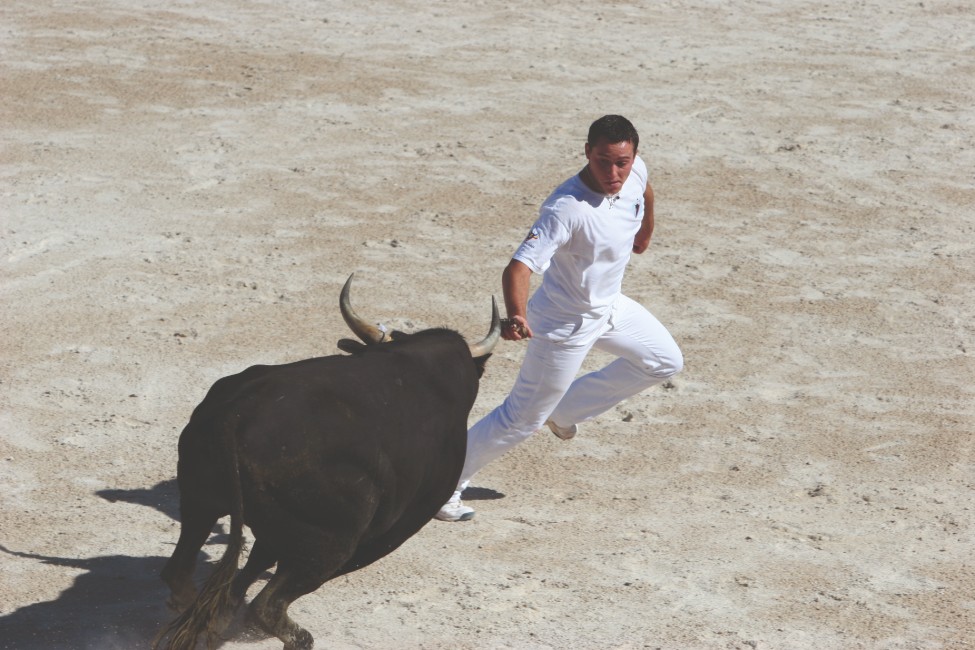
A raseteur plays a game of cat and mouse with a bull. Photo: Georges Vlassis
Bulls here are fed high-quality diets to increase their strength and resilience, as it is the feisty ones that create the most memorable spectacles. And, when they eventually retire from the ring – typically at around 15 years old – they are left to graze happily on fertile pastures for the rest of their lives. By animal standards, this is a luxurious retirement. After their death (of old age), statues are erected in their names. Even their funerals include rituals of respect – for example, laying a bull to rest with its head facing towards the sea.
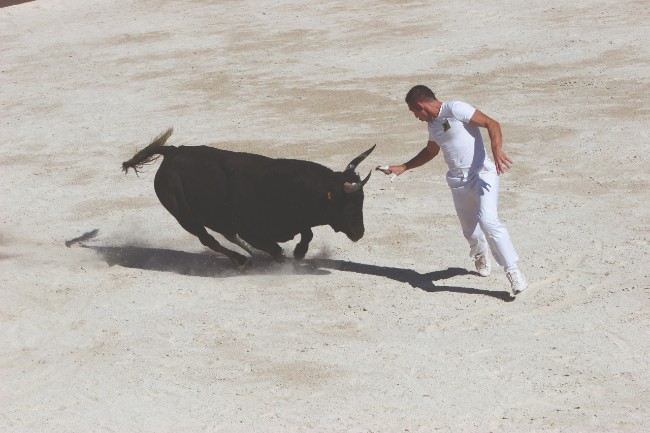
The course Camarguaise. Photo: Georges Vlassis
Only naturally aggressive bulls are chosen for the course Camarguaise – those who do not make the grade are destined to become meat. Therefore, counter-intuitively, buying into this sport actually prolongs animals’ lives.
PRIMAL THRILL
There is something about this outwardly dangerous sport that inspires passion in local men. As Gérard Barbeyrac, director of the French Federation of Camargue Races, insists: “If there was no risk involved, the races would die out.” Raseteurs are looking for the primal thrill of taming – and daring to antagonise – a dangerous beast. Each fight awakens their subconscious desires for conquest. The sport even attracts groupies; usually women impressed by the macho, warrior-like traits of these fighters.
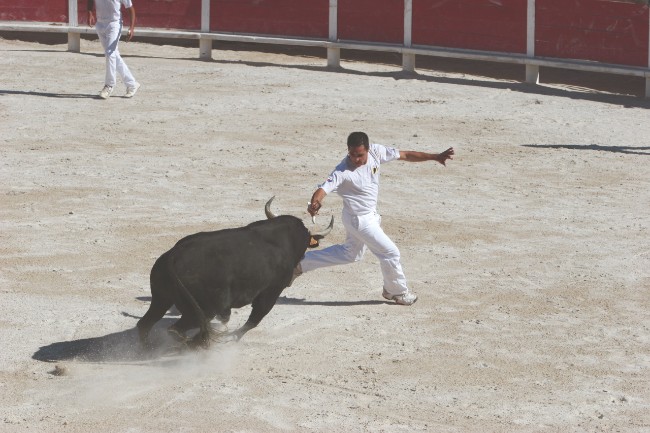
The course Camarguaise. Photo: Georges Vlassis
Yet pursuing this as a career is nowhere near as lucrative as in Spain, where fighters are not merely awarded similar status to a premiership footballer, but receive the wages to match, too. It is not unusual for Spaniards to earn five times more than the Prime Minister; while in contrast, the city of Arles ended up €300,000 in debt just a decade ago due to the cost of maintaining the fights. The French are in it not for the financial gain, but the adrenalin rush and the opportunity to boastfully display their agility and courage. Despite its more humane approach, like traditional bull fighting, course Camarguaise is not without risk. In fact, some raseteurs enrol in bullfighting school, where they learn, among other things, how to scale the barriers at top speed to escape if – and undoubtedly when – things get too heated in the ring.
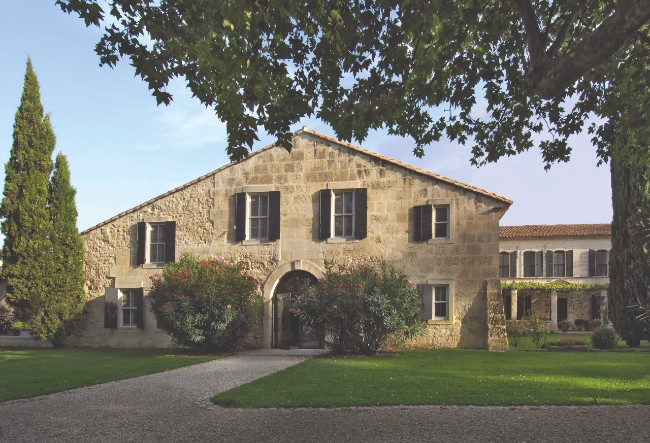
A warm welcome awaits guests at Mas de Peint
Former Camarguaise champion Mickaël Matray paid the price for his temerity, once suffering six broken ribs and a ruptured spleen. The bull, on the other hand, was totally nonplussed – and unbelievably, Matray was too, as he returned straight back to the ring after he’d healed. Another fighter, now confined to a wheelchair, has passionately declared that he regrets nothing and would do it all again in an instant.
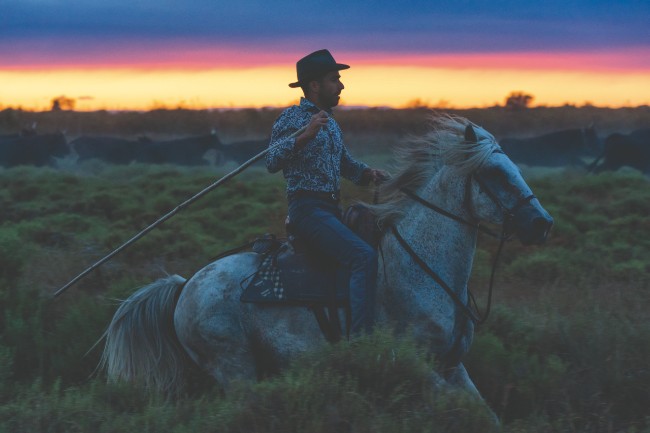
A cowboy herding the cattle at the Mas de Peint ranch. Photo: © GEORGES VLASSIS
The sport inspires mixed opinions, but the only way to make a judgment is to see it first-hand. So I duly set off to rural Camargue, the heartland of the bull. Driving alongside miles of marshy pasture and wilderness, I soon reach Mas de Peint, a 17th-century farmhouse so isolated that it has its own bus stop. This is a genuine working ranch, with a sweeping 550-hectare estate boasting both rice fields and pasture for bulls and horses. Naturally, it also has its own arena for fights. The owners – cattle rancher Jacques Bon and his architect wife Lucille – inherited the property from one of Jacques’s wealthy and powerful forefathers, who had lent money to the city of Arles after it faced financial difficulties. Unable to repay him, the government unexpectedly offered the farm as compensation – and, proudly continuing ancestral traditions, his relatives haven’t looked back since.
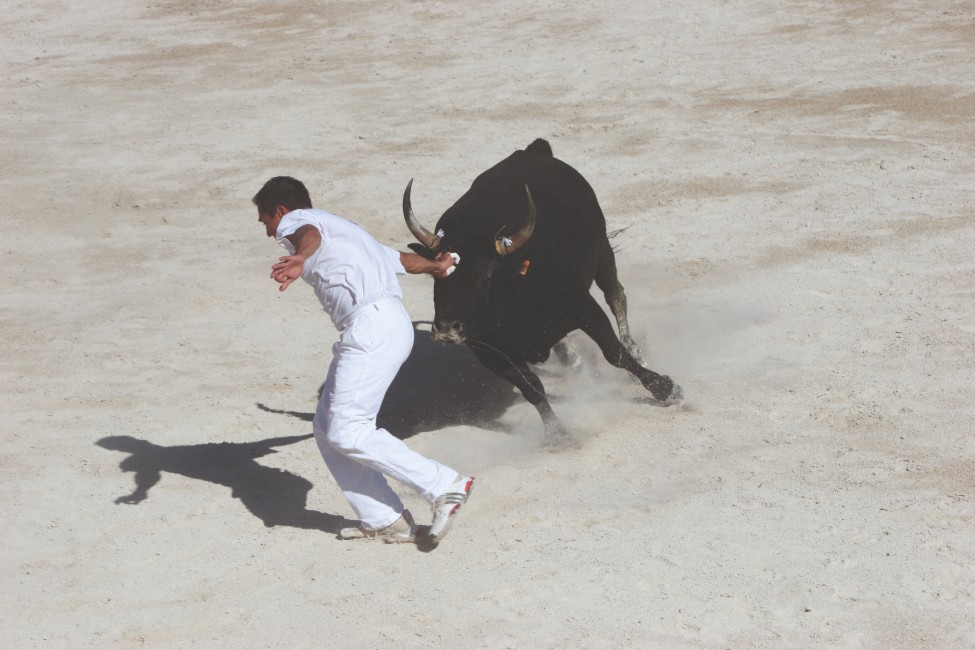
The course Camarguaise. Photo: Georges Vlassis
Tourism is a comparative afterthought, with just eight guest rooms, which only adds to the ferme’s authenticity. Each room offers simple comforts, with traditional beamed ceilings and plenty of old-world charm.
After a night’s rest, I am invited to a display of traditional Camarguaise activities: an opportunity to see how the fights operate. Several athletic men jump into the ring to demonstrate. They simply run into the animal’s path until it follows in hot pursuit. The balance of power here is clearly in the bull’s favour and when it tires of the raseteur darting around the ring, it just stops, putting an end to the race. There is no coercion involved and the bulls are not trained or controlled through trauma. They merely have a genuinely confrontational spirit – when they wish to display it.
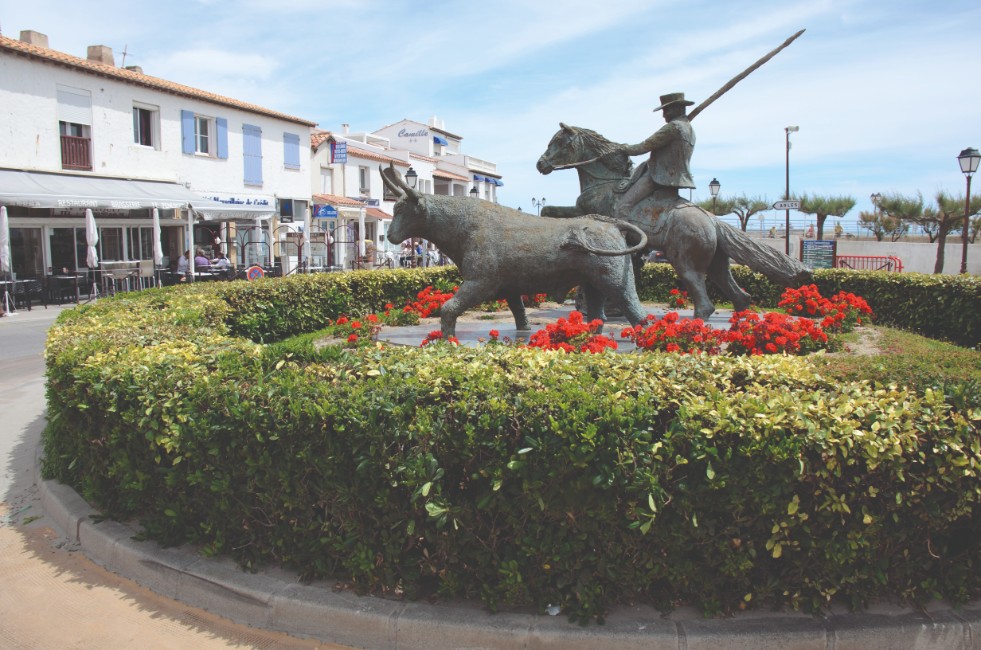
A decorated roundabout at Saintes-Maries-de-la-Mer, the capital of the Camargue, pays homage to the area’s bullfighting tradition. Photo: Henk Monster/ Wikimedia Commons
CEREMONIAL BRANDING
The ceremonial branding of a young bull, undertaken to prevent animals from roaming or being poached, is the only exception to this ‘no-coercion’ tack; and it is rather difficult to watch. A group of ranchers gallop in on horseback, their victim on a lead alongside. Fiercely resistant, the spirited calf writhes and squirms wildly, kicking out at the gardiens desperately trying to restrain it. It takes four men – two to hold its ears, one to hold its tail taut and another as back-up – just to coax the calf into a horizontal position. In seconds, the branding is over, with the symbol ‘B’ for ‘Bon’ now decorating its flank, steam rising into the air around it. The traditional lunch served up after the event is quite the meaty affair and decidedly not one for vegetarians. Jacques’s son marches into the room, holding a huge plate triumphantly above his head to the sounds of trumpets from the accompanying band. The meal is leg of bull with rice grown in the fields surrounding us.
My visit drawing to a close, I picture once more the bull charging at the raseteur, stalking and challenging its human opponent. While brutal Spanish-style fights are still a fixture in southern France, in Camargue’s rather more humane battle of wills, it’s the bulls that call the shots.
From France Today magazine
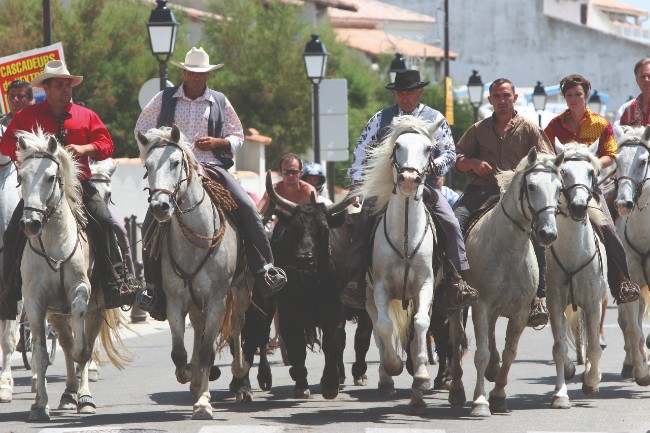
A bull is led through the streets. Photo: Georges Vlassis
Share to: Facebook Twitter LinkedIn Email
By Chloe Govan
Leave a reply
Your email address will not be published. Required fields are marked *




REPLY